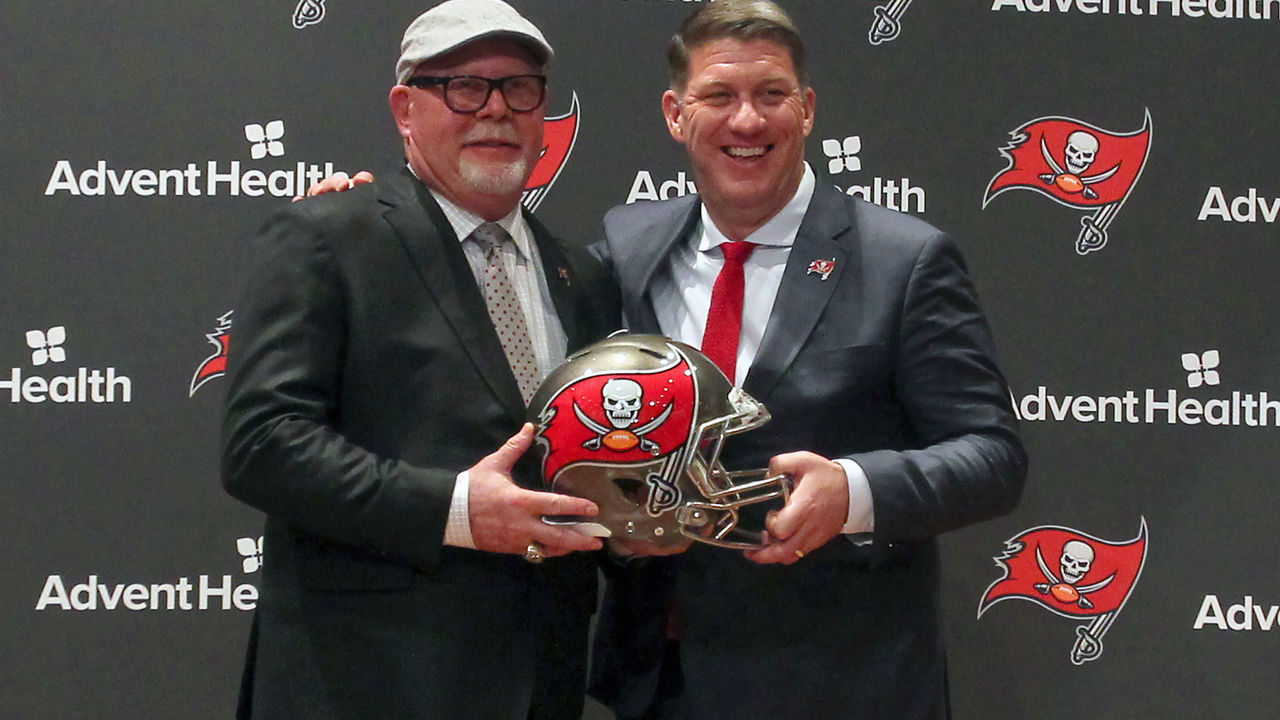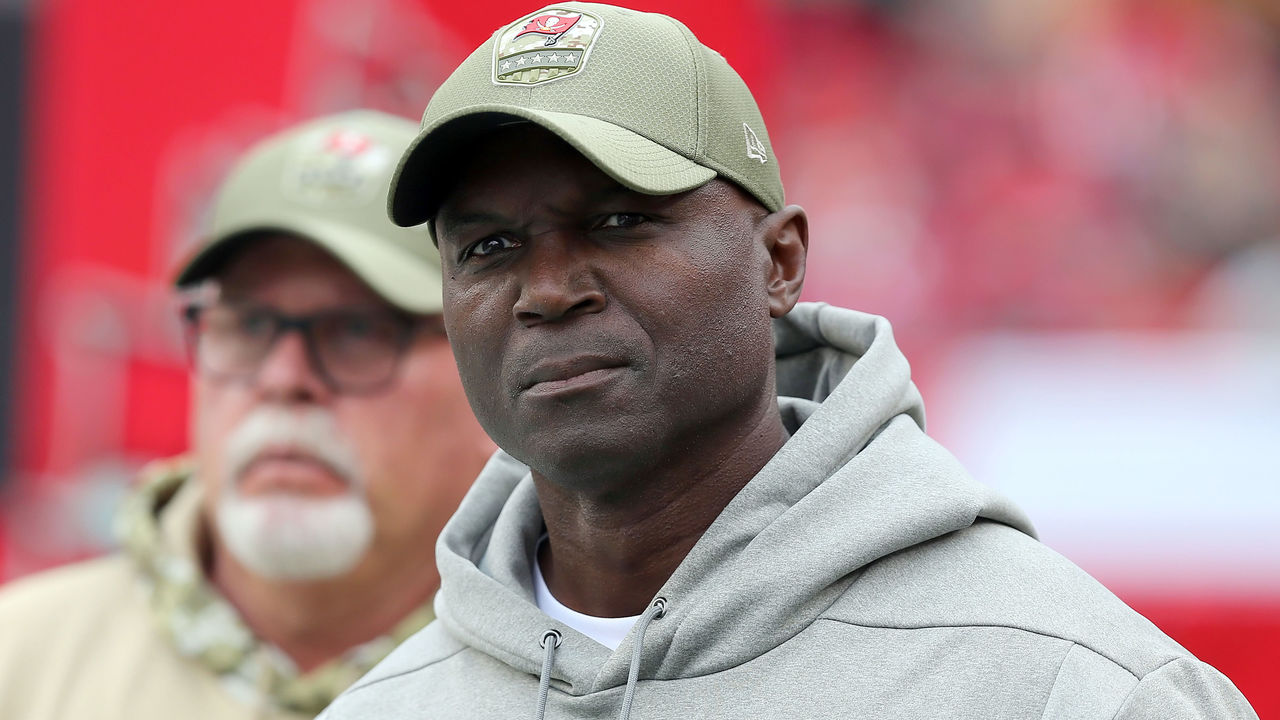How the NFC champion Buccaneers were built
The Tampa Bay Buccaneers could win their second Super Bowl in team history this Sunday, and do it on their home field.
The 2020 Buccaneers' story would make for a compelling Hollywood script. Just how did a franchise that went 12 seasons without a playoff appearance find itself in Super Bowl LV with Tom Brady as the team's quarterback?
Here's how Tampa Bay was built.
Key players
| Year | Draft | Free agent | Trade |
|---|---|---|---|
| 2012 | LB Lavonte David | ||
| 2013 | DE William Gholston | ||
| 2014 | WR Mike Evans | TE Cameron Brate | |
| 2015 | LT Donovan Smith | ||
| LG Ali Marpet | |||
| 2016 | |||
| 2017 | WR Chris Godwin | ||
| TE O.J. Howard | |||
| 2018 | DT Vita Vea | C Ryan Jensen | DE Jason Pierre-Paul |
| RB Ronald Jones | |||
| CB Carlton Davis | |||
| RG Alex Cappa | |||
| S Jordan Whitehead | |||
| 2019 | LB Devin White | DT Ndamukong Suh | |
| CB Sean Murphy-Bunting | LB Shaq Barrett | ||
| CB Jamel Dean | P Bradley Pinion | ||
| S Mike Edwards | |||
| WR Scotty Miller | |||
| 2020 | RT Tristan Wirfs | QB Tom Brady | TE Rob Gronkowski |
| S Antoine Winfield Jr. | RB Leonard Fournette | ||
| WR Tyler Johnson | WR Antonio Brown | ||
| RB LeSean McCoy | |||
| K Ryan Succop |
Foundation laid through the draft

The perception is that aging stars lead this Buccaneers team. The reality is the NFC champions were built primarily through the draft and supplemented by this year's offseason additions.
Star linebacker and 2012 second-round draft pick Lavonte David endured multiple losing campaigns and is just now experiencing his first postseason. Other long-suffering Bucs players are 2015 second-rounder Donovan Smith, 2017 third-round choice Chris Godwin, and 2014 first-round pick Mike Evans, the first selection of general manager Jason Licht's regime.
Licht has often been ridiculed for his wild swings and misses, particularly his daring decision in 2016 to trade up to draft kicker Roberto Aguayo in the second round. Taking kicker Matt Gay in the fifth round in 2019 was Licht's attempt to make up for that failed selection. Neither player was with the team for more than one season.
Before 2019, Tampa Bay's record under Licht was 27-53, with one winning season over five years. There was a belief that Licht would be fired after the 2018 campaign. Instead, he was given another chance and then hired head coach Bruce Arians before signing a new four-year deal.
Licht deserves praise for his recent draft record. The last three drafts have yielded 13 contributors and eight starters. Ronald Jones, a 2018 pick, emerged as the team's leading rusher, and 2020 first-round pick Tristan Wirfs has started every game this season at right tackle, allowing just one sack.
The defense was built primarily through the draft. Stud linebacker Devin White was a 2019 top-five pick, and the entire starting secondary - including Carlton Davis, Sean Murphy-Bunting, Jamel Dean, and rookie safety Antoine Winfield Jr. - is homegrown.
Paying for a pass rush

As successful as the Bucs have been at building the back half of their defense through the draft, they struck out picking players who can rush the quarterback and used other means to assemble a pass rush.
First came the trade for Jason Pierre-Paul ahead of the 2018 season. The Bucs sent 2018 third- and fourth-round picks to the New York Giants for Pierre-Paul. In the three campaigns since, JPP has racked up 30.5 sacks. He led the team with 9.5 sacks this year and added another two in the playoffs.
Tampa Bay took a flier on Shaq Barrett in 2019, signing the former Denver Bronco to a $4-million prove-it deal. He ended up leading the NFL in sacks with 19.5. He re-signed on the franchise tag the following offseason and saw more attention from opposing offenses, ending the campaign with eight sacks. Barrett has come alive in the playoffs, sacking Aaron Rodgers three times in the NFC Championship Game.
Then there's Ndamukong Suh. The defensive tackle signed a $9.25-million, one-year deal in 2019 and re-upped for $8 million this season. Paired with Vita Vea, the two have spearheaded the NFL's No. 1 run defense in 2020. Suh also contributed six sacks, his most since 2015.
The Buccaneers now own a formidable pass rush brimming with confidence and are preparing to face two backup tackles in the Super Bowl.
Diverse coaching staff

With the makings of a contender in place, the Buccaneers needed a proven coach to lead them over the hump. Dirk Koetter was fired after a 5-11 record in 2018, and in what was likely his last chance as GM, Licht turned to an old friend for help.
Arians worked with Licht during his time coaching the Arizona Cardinals but retired in 2018 due to health issues. Licht not only needed to lure Arians out of retirement to get the two-time Coach of the Year, but he also had to exchange draft picks with the Cardinals to seal the deal.
Arians brought a progressive staff with him to Tampa Bay. He hired Black men in all four coordinator positions, including former NFL quarterback Byron Leftwich as his offensive coordinator and Todd Bowles as the defensive coordinator. He also added two full-time female coaches to his staff, installing Lori Locust and Maral Javadifar as assistants.
The Bucs set franchise records in points and touchdowns during Arians' first season in Tampa, but the club finished 7-9 and missed the playoffs for the 12th consecutive year. Despite leading the league in passing yards, quarterback Jameis Winston played out his contract by throwing 33 touchdowns and 30 interceptions. The Buccaneers were also the NFL's most penalized team.
Tampa entered the offseason with two goals in mind: To retain its defensive free agents and reel in the biggest quarterback on the market.
Dream Team additions

With the foundation set, the Buccaneers were able to add marquee free agents, most notably Tom Brady.
After 20 years in New England, Brady's path no longer aligned with the Patriots. The veteran had particular characteristics in mind for his new team. Entering his age-43 season, he wanted a squad loaded with playmakers, which the Bucs possess in spades. Tampa boasted a pair of receivers in Evans and Godwin coming off 1,000-plus-yard campaigns, and play-callers that lived by the "no risk it, no biscuit" credo.
Despite returning almost the same team, minus Winston, that finished 7-9 a year prior, Brady signed on the dotted line.
The floodgates opened after Brady decided to chase a seventh championship in Tampa Bay. The next one in was Rob Gronkowski. The future Hall of Fame tight end cut his retirement short to play with his favorite quarterback in a friendlier atmosphere than Bill Belichick's notorious business-like environment.
Then running back LeSean McCoy signed for the veteran's minimum. He was coming off a Super Bowl victory with the Kansas City Chiefs and was brought in to challenge Jones for the starting gig while also filling a vital pass-catching role out of the backfield.
That was until the Jacksonville Jaguars cut 2017 No. 4 pick Leonard Fournette, who then signed with the Bucs a week before the season. It was too late to supplant Jones as the starter, but he pushed McCoy to a reserve role. Jones and Fournette would share lead-back duties, with the latter coming up clutch during the postseason run.
Finally, Antonio Brown joined the fray in October. With other NFC contenders rumored to be in the running to add the receiver after his eight-game suspension, the Bucs couldn't pass up the chance to improve their depth at wideout. Evans and Godwin each battled injuries early in the season, leaving the offense without its biggest threats.
Brady, Gronkowski, Fournette, and Brown each played a vital role in getting the Buccaneers to Super Bowl LV. But the Bucs wouldn't have been in a position to build a veritable "dream team" if not for the formidable core compiled through the draft.